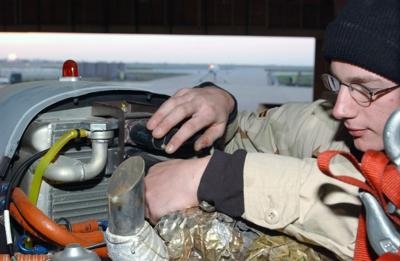Ruggedized Fuel Cell Power Source Enables Persistent
Surveillance On Small-Footprint, Low-Cost System
Small unmanned aircraft systems (UAS) provide valuable
intelligence, surveillance and reconnaissance (ISR) capabilities
for units at the infantry company level and below, allowing
over-the-next-hill imagery or short-term monitoring of convoys as
an example. State-of-the-art battery power for these small UASs,
however, has limited the duration of missions to about two
hours.
DARPA Technician Works On Fuel Cell DARPA
Image

DARPA's Tactical Advanced Power (TAP) program has addressed the
power limitation by developing a compact solid oxide fuel cell
(SOFC) fueled by propane, a very high energy density hydrocarbon
fuel. DARPA researchers have also developed the Stalker XE, a small
UAS powered by this fuel cell to provide extended mission endurance
for more than eight hours with the reliability and ruggedness
required to perform real-world missions. The Stalker XE has
demonstrated an improvement of more than four times the endurance
of existing state-of-the-art small unmanned aircraft systems. "A
small unmanned aircraft system with long-endurance capability could
give the military the ability to do with a small craft what has
previously been doable only with larger airframes. This has
potential for tremendous cost savings - we can maintain and even
improve on our UAS capabilities with a much smaller footprint and
lower operating cost," said Brian Holloway, DARPA program manager
for this effort.
The fuel cell was the basis for the hybrid power source on the
Stalker XE, in which the high energy density fuel cell system was
combined with a conventional lithium polymer battery to handle peak
power requirements. Its high energy density hydrocarbon fuel to
handle energy storage rather than a relatively low energy density
battery. The Stalker XE enables persistent surveillance operations
for small units. As a 22-pound bungee-launched system, it operates
without the large footprint and high cost of current tactical UAS
platforms.

The enabling technology is the compact SOFC developed by DARPA
for portable power applications, but the notable achievement of the
Stalker XE demonstration is ruggedization of the advanced SOFC
power source and integration into a fieldable platform. Stalker XE
was subjected to rigorous flight-testing, where it was required to
perform back-to-back flights on a single airframe and single fuel
cell with turnaround times of less than 30 minutes. During these
tests, the aircraft encountered wind gusts of 46 mph and sustained
winds as high as 28 mph. The system also performed at altitudes of
greater than 15,000 feet.
The TAP portfolio program develops advanced portable power and
energy in program efforts ranging from fundamental materials and
chemistry to systems engineering of mature portable power systems.
The fuel cell power source in the Stalker XE was developed and
matured under DARPA's Palm Power and Robust Portable Power Sources
programs. Under the TAP program, the fuel cell system was
ruggedized for integration into a fieldable small UAS.
"Stalker XE is a great example of how TAP may help reduce
logistical burdens, enhance mission capability and fundamentally
change how the U.S. military uses power and energy," said
Holloway.
 ANN's Daily Aero-Linx (08.27.25)
ANN's Daily Aero-Linx (08.27.25) ANN's Daily Aero-Term (08.27.25): Class C Service
ANN's Daily Aero-Term (08.27.25): Class C Service ANN FAQ: Submit a News Story!
ANN FAQ: Submit a News Story! Airborne-NextGen 08.26.25: Iran UAV Knockoffs, X-37B Spaceplane, Army Training
Airborne-NextGen 08.26.25: Iran UAV Knockoffs, X-37B Spaceplane, Army Training Classic Klyde Morris (08.25.25)
Classic Klyde Morris (08.25.25)




